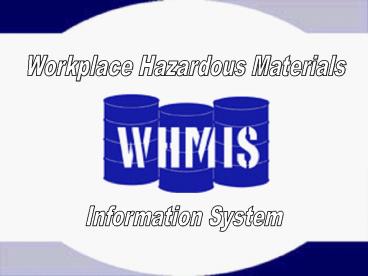Workplace Hazardous Materials - PowerPoint PPT Presentation
1 / 18
Title:
Workplace Hazardous Materials
Description:
Not Classified as Controlled Products Explosives Radioactive Materials Not Classified as Controlled Products Domestic Goods Cosmetics Not Classified as Controlled ... – PowerPoint PPT presentation
Number of Views:114
Avg rating:3.0/5.0
Title: Workplace Hazardous Materials
1
Workplace Hazardous Materials
Information System
2
What is WHMIS?
- Workplace Hazardous Materials Information
System. - This system provides workers and employers
nationwide with vital information about hazardous
materials. - It has been in effect since October 31, 1988.
- It was developed through a combined initiative
involving labor, industry, and federal/provincial/
territorial governments.
3
"Approximately one in four
Canadian workers are exposed
to chemical or biological
hazards on the job."
4
- It satisfies the employees legislated right to
know about the hazards they may encounter during
the course of work. - WHMIS protects the health and safety of
employees by reducing the occurrences of injury
or illness caused by hazardous materials in the
workplace. - WHMIS legislation applies to controlled
products, which are used, stored and handled at
any workplace. - A controlled product is any hazardous substance
or material, which meets or exceeds the criteria
foe inclusion in one or more of the WHMIS hazard
classes.
5
Classes of WHMIS
controlled products . . .
6
Not Classified as Controlled Products
- Explosives
- Radioactive Materials
7
Not Classified as Controlled Products
- Domestic Goods
- Cosmetics
8
Not Classified as Controlled Products
- Food Food Additives
- Drugs Diagnostic Chemicals
9
Not Classified as Controlled Products
- Pesticides
- Hazardous Waste
10
Classes of WHMIS
controlled products . . .
11
Class A
Compressed Gas This class includes compressed
gases, dissolved gases and gases liquefied by
compression or refrigeration.
- Heat may cause the container to explode, it
should be stored away from heat or potential
sources of ignition. - A drop or impact may cause this container to
explode, so handle with care. - EXAMPLES Cylinders of acetylene, oxygen,
nitrogen, hydrogen, helium, neon, chlorine,
ammonia, and fire extinguishers.
12
Class B
Flammable and Combustible Material Solids,
liquids, gases capable of catching fire or
exploding in the presence of a source of ignition.
- This material is a potential fire hazard.
Sparks, flame or friction could ignite it. - May burst into flames spontaneously in air or
release a flammable gas on contact with water, It
may burn at relatively low temperatures. - Never smoke when working with or near these
materials. Store in a cool, fire-proof area. - EXAMPLES hydrogen, methane, propane, kerosene,
diesel fuel, white phosphorus, magnesium, sodium,
and butane
13
Class C
Oxidizing Material Materials that provide oxygen
or similar substance and which increase the risk
of fire if they come in contact with flammable or
combustible materials.
- This material is a fire or explosion risk near
flammable or combustible material. - Keep the material away from sources of ignition
and never smoke when working with or near the
material. - May burn skin or eyes on contact.
- EXAMPLES sulphuric acid, hydrogen peroxide,
chlorine and hypochlorites (AKA Javex)?
14
Class D
Division 1
Poisonous and Infectious Material
Immediate and serous toxic effects This division
covers materials which can cause death of a
person to small amounts.
- Handle the material with extreme caution, it may
be fatal or cause permanent damage if it in
inhaled, swallowed or absorbed through the skin. - May burn skin or eyes. Wash and shower thoroughly
after using. - Avoid inhaling by working in well-ventilated
areas and/or wearing respiratory equipment. - EXAMPLES sodium cyanide, hydrogen sulphide.
15
Class D
Division 2
Poisonous and Infectious Material
Other toxic effects this division covers
materials which cause immediate eye and skin
irritation as well as those which can cause
long-term effects in a person repeatedly exposed
to small amounts.
- This material is poisonous but not immediately
dangerous to health, death or permanent damage
result from repeated exposure over time. - May be a skin irritant, a sensitizer causing
allergic reactions, cause cancer, cause birth
defects or sterility. - Avoid skin and eye contact along with inhalation
while working with these products by wearing the
proper protective equipment. - EXAMPLES acetone, asbestos and toluene
diisocyanate.
16
Class D
Division 3
Poisonous and Infectious Material
Biohazardous/Infectious Material this division
applies to materials which contain harmful
microorganisms.
- May cause a serious disease resulting in illness
or death. Take every measure to avoid
contamination. - Handle the material only when fully protected by
the proper, designed equipment. - Store in designated areas only.
- EXAMPLES cultures or diagnostic specimens
containing salmonella bacteria or the hepatitis B
virus.
17
Class E
Corrosive Material acid or caustic materials
which can destroy the skin or eat through metals.
- Causes severe eye and skin irritation upon
contact and will cause severe tissue damage with
prolonged contact. - May be harmful if inhaled. Avoid inhaling by
using well-ventilated areas only and/or wearing
the proper respiratory equipment. - EXAMPLES sulphuric acid, sodium hydroxide,
hydrofluoric acid, some household cleaners,
water treatment chemicals, ammonia and hydrogen
chloride.
18
Class F
Dangerously Reactive Material products which can
undergo dangerous reaction if subjected to heat,
pressure, shock, or allowed to contact water.
- The material is very unstable, undergoes
vigorous polymerization. - May react with water to release toxic or
flammable gas - Open containers carefully, do not drop.
- Store material in designated cool, flameproof
areas. - EXAMPLES calcium carbonate, benzoyl peroxide,
copper and mercury azides































